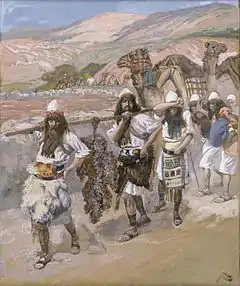Adurim
Adurim is a town mentioned in the Bible and the Apocrypha and related information. This town is listed by different sources as Adurim, Adoraim, Adora and Dora. During the Roman era, the city was inhabited by Esau's descendants.[1] Today, the place corresponds with Dura, near Hebron.
Etymology
The city was called by Macabees Adora (1 Macc. 13.20).[2] According to Guy Le Strange, the city locality is in the Vale of Mamre mentioned in the story of The Twelve Spies who brought back to Moses large grapes of Eshkol as recorded in the Book of Numbers.[3]
Mentioned as Adora by Apocrypha and often by Josephus.[4] A weak letter is usually lost in Hebrew to Arabic sound conversion, such as in the case of Adoraim to Dura.[5] A loss of a first feeble letter is not uncommon and the form of Dora could be found as early as in several instances of Josephus writings.[4]
Apocrypha and biblical references

According to the International Standard Bible Encyclopedia: "ADOR, ā'dor, ADORA, a-dō'ra (’Αδωρά, Adōrá): In Idumaea, mentioned in Ant, XIII, ix, 1 as one of the cities captured by Hyrcanus, and referred to in 1 Maccabees 13 20."[6]
Some believe Noah, the tenth of the pre-flood Patriarchs, as the story of Noah's Ark is told in the Hebrew Bible, is buried in Dura.[2] The city was fortified by Rehoboam (974 BC – 913 BC), King of the United Monarchy of Israel and later the King of the Kingdom of Judah, who was a son of Solomon and a grandson of David, according to 2 Chron. 11.9. The city was called Adora in the First Book of Maccabees (1 Macc. 13.20).[2]
According to the biblical account, Adurim was fortified by Rehoboam (974 BC – 913 BC), King of the United Monarchy of Israel and later the King of the Kingdom of Judah, who was a son of Solomon and a grandson of David. In the early 6th century BC the Babylonians attacked the Kingdom of Judah, the southern part of the country, from Adoraim near Hebron to Maresha and beyond, fell to the Edom.[7][8] The settlement is mentioned in the Zenon Papyri in 259 BC as a "fortress city".
Historical sources and archaeology
Babylonian period
In the early 6th century BCE the Babylonians attacked the Kingdom of Judah, and the southern part of the country, from Adoraim near Hebron to Maresha and beyond, fell to Edom.[9][10]
Hellenistic period
Following Alexander the Great's conquest, the village population preserved their traditional way of life, however Jewish urban centers such as Adoraim exhibited a degree of hellenisation.[11] The settlement is mentioned in the Zenon Papyri in 259 BCE as a "fortress city". In Adora, Simon Maccabeus stopped the advancing army of Diodotus Tryphon in 142 BCE.[12]
According to Josephus, John Hyrcanus captured the city after the death of Antiochus VII in 129 BCE. The city inhabitants, who were alleged to have been of Esau's progeny (Idumeans), were forced to convert to Judaism during the reign of Hyrcanus, on the condition that they be allowed to remain in the country.[13] Hyrcanus "hired foreign troops, dismantled Adora and Marissa, the strong places of Edom, and forced the Edomites to accept the Jewish religion and submit to circumcision. This is the first instance of forcible conversion in Jewish history." [14]
Roman period
Adora may have been the administrative center of the district of eastern Idumaea established by the Roman consul Aulus Gabinius, though other possibilities have been suggested.[15]
See also
References
- Josephus, Antiquities of the Jews 13.9.1
- Berrett, 1996, p. 196
- Mukaddasi, 1895, p. 69
- Edward ROBINSON (1841). Biblical researches in Palestine, mount Sinai and Arabia Petrea. J.Murray. p. 4.
- Conder, CR (1876). "Notes on the Language of the Native Peasantry in Palestine" (PDF). Palestine Exploration Quarterly (Taylor & Francis). Retrieved Mar 25, 2018.
- James Orr (1915). The International Standard Bible Encyclopaedia. Howard-Severance Company. p. 60.
- Lindsay, John. "The Babylonian kings and Edom, 605–550 BC." Palestine Exploration Quarterly 108, no. 1 (1976): 23-39.
- Albright, William F. "Ostracon No. 6043 from Ezion-Geber." Bulletin of the American Schools of Oriental Research 82 (1941): 11-15.
- Lindsay, John. "The Babylonian kings and Edom, 605–550 BCE." Palestine Exploration Quarterly 108, no. 1 (1976): 23-39.
- Albright, William F. "Ostracon No. 6043 from Ezion-Geber." Bulletin of the American Schools of Oriental Research 82 (1941): 11-15.
- Lee I. Levine (1 March 2012). Judaism and Hellenism in Antiquity: Conflict or Confluence?. University of Washington Press. p. 25. ISBN 978-0-295-80382-1.
- Kraeling, Emil G. "Two Place Names of Hellenistic Palestine." Journal of Near Eastern Studies 7, no. 3 (1948): 199-201.
- Josephus, Antiquities (Book xiii, chapter ix, verse 1).
- Richard Gottheil, Mayer Kayserling (1906)."Hyrcanus, John (Johanan) I." Jewish Encyclopedia.
- Avi-Yonah, 1977, pp. 83–84
Bibliography
- Berrett, L.M.C. (1996). Discovering the World of the Bible. Grandin Book Company. p. 196. ISBN 9780910523523. Retrieved 2 December 2014.
- Mukaddasi (1895). Description of Syria, including Palestine. Translator: Guy le Strange. Palestine Pilgrims' Text Society.